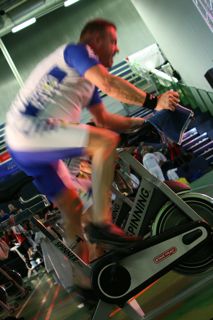Now that you know about the physiological adaptations of VO2 Max intervals, here are five different profiles for introducing VO2 max intervals. Each one is progressively harder. Also provided are some modifications for your students who are still not ready to go to this intensity for very long. This is important if you have classes that aren’t always the same students.
In the previous article on VO2 max, you learned about the physiological adaptations that take place when you do intervals at this very hard intensity for at least four minutes. When you train at VO2 max intensity for the prescribed duration, you will induce adaptations that enhance your ability to train here.
It’s as simple as that: to get better at something, you’ve got to do that something!
But as I stressed in the first article, this intensity—especially for that long—is not for everyone.
Begin with just one or two at this intensity, and then gradually increase the number. After you’ve increased the number of VO2 max intervals, you can begin increasing the duration. Spending a longer time at this intensity this far above lactate threshold is much harder than doing more shorter ones. You risk degrading the quality of the interval if riders aren’t properly prepared through a progressive introduction to this intensity.
Before introducing these intervals, make sure your riders have a solid aerobic base. How do you know they have an aerobic base? You should know their history. Have they been attending your classes for a long time? Have they developed the ability to work at a moderately hard intensity for an extended period of time? Can they sustain a threshold intensity for at least 20 minutes? Then they are probably ready to at least try some of these. If they are outdoor cyclists who ride several hours at a time once or twice a week, then they have even more of a base.
In the profiles below, I also give you some suggestions for modifying the effort for your newer and/or less fit students.


Is this a mistake under “Profile 2”?
“2X7 minutes at LT, with a 3min recovery. Your choice for terrain and cadence.
Recover for 5 minutes in between @ Z2”
“2 x 7 minutes at LT”? Is that supposed to be “2 x 1 minute” ?
Thanks!
Hi Tracy, no, it’s correct. Seven minute efforts at lactate threshold (which if you have power, is at your FTP), are hard but not excessively hard. It’s the precursor to the shorter higher-intensity efforts at VO2 max, which is above LT.
However, now that I’ve been doing this a lot longer (I wrote that 10 years ago), I would probably either do two 7-minute efforts just below LT (an intensity we call “sweet spot,” or ramp it up and do a 5-minute one first, follower by a 6- or 7-minute one at LT. It wasn’t incorrect, but I’m a little bit nicer these days, and fewer of my riders are as serious about cycling as my previous demographic was! Those VO2 max intervals are very hard. 😉
Jennifer,
When you do these types of intervals, what type of a music mix do you put together? Do you match the music and time each interval to each song or do you just stream line the mix? Do you stay consistent with rmps through your mix or does it vary?
Thank you Jennifer,
I am always looking for new ways to communicate “be kind to yourself” in my beginner classes.
I have been doing LT classes anear the end of 8 – 9 week sessions and they have gone over well.
I just wish we had power meters.
Yes, that’s about the equivalent. LT is at the top of zone 4 for the zones I’m referring to (the most common zones used in cycling and other endurance sports), but the truth is, it doesn’t really matter which zone methodology you use, as long as it’s communicated to students.
I will do an article just about HR zones soon. A 3 zone methodology using “easy” “moderate” and “hard” is the most simple for the less fit and people new to exercising. Than as they become more fit and more interested in targeting their goals a little more, you can transition to a slightly more complicated zone system, with anywhere from 4-7 zones.
Jennifer.
When you talk about Z2 & Z3 it’s 60-70% MHR (Z2) and 70-80% MHR (Z3) right?
That would be an excellent metric to have. And I bet being able to see quantifiable improvements in your PPV for that 4 min effort is really gratifying. with HR, it’s not as easy to see any kind of improvement. It’s always going to be subjective.
Although, you could use a certain hard climb outdoors and time yourself. Say you can ride hard on a certain hill with 8% grade and go 500m in exactly 4 min. Then with this kind of training, you can now ride 550m in the same 4 min. What a perfect representation of your improvement in your PPV!
Hi Jennifer, for those out there training on an indoor cycle equipped with a power measuring device, Allen Lim recommends using one’s 4 min. PPV (peak power value) for power @ VO2Max. 30 min. PPV correlates to power at lactate threshold. The Joule on the CycleOps bike will be able to extrapolate one’s PPV for numerous durations. i.e. 5 sec., 10 sec., 1 min., 5 min…..
Danielle